Welcome to the world of Laravel package development, where you can enhance your coding efficiency, maintainability, and reusability.
Whether you’re a seasoned Laravel developer or a beginner, creating custom packages can significantly impact your development workflow.
In this comprehensive guide, we’ll delve into the realm of Laravel package development, providing detailed insights and step-by-step instructions.
By the end of this blog, you’ll be equipped to craft powerful and reusable Laravel packages that contribute to your projects and the broader Laravel community.
What Are Laravel Packages?
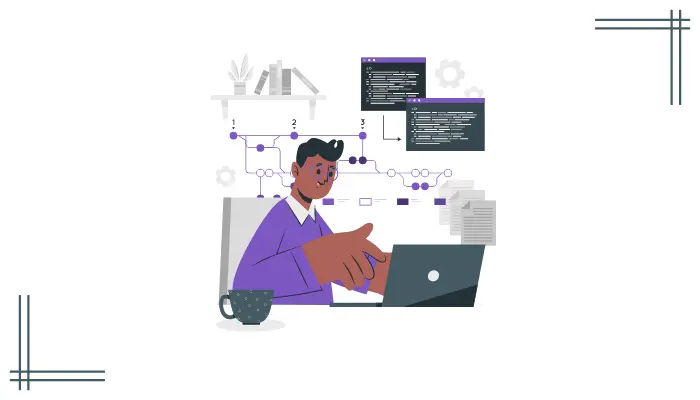
Being one of the most popular frameworks of PHP, laravel web development is popular enough.
However, there are high chances that entire laravel package concept is new to you. So, let us introduce it to you.
Laravel packages are modular, reusable units of code that can be seamlessly integrated into your Laravel projects.
They encapsulate specific features or functionalities, ranging from authentication systems to complex tools like content management systems.
This begs the question, why is laravel packaging important? Well, let’s answer that in the section below.
Importance of Laravel Packages
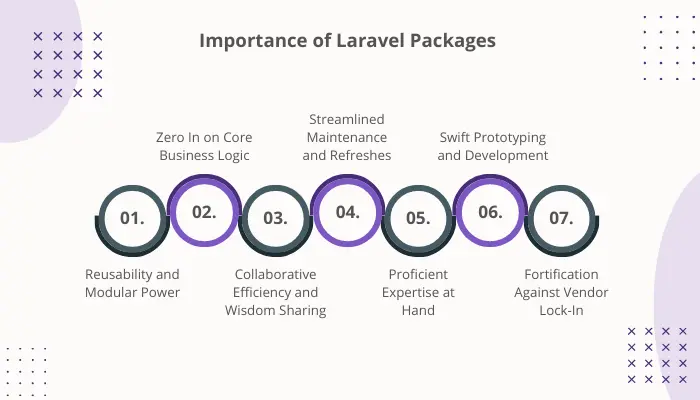
In your dynamic web development expedition, Laravel emerges as a shining star, celebrated for its refined syntax, powerful features, and developer-friendly environment.
At the heart of Laravel’s effectiveness lies its ingenious packaging system.
Let’s uncover the pivotal importance of Laravel packages and how they revolutionize your development endeavors.
-
Reusability and Modular Power
Laravel packages encapsulate distinct functions – think authentication systems, payment gateways, and even sophisticated content management systems.
With packages, you craft reusable code units that effortlessly fit into multiple projects. This reusability curbs redundancy and slashes time spent recreating the wheel for each project.
Moreover, the modular charm of packages fosters neat separation of tasks, leading to a well-organized, easily maintainable code foundation.
-
Zero In on Core Business Logic
By embracing pre-built packages for everyday functions, you zero in on your application’s core business logic.
This laser-focused approach diminishes the effort spent on routine features.
This allows you to channel your energy into crafting unique, value-packed elements that distinguish your app in the bustling landscape.
-
Collaborative Efficiency and Wisdom Sharing
The Laravel realm thrives on a vibrant community of developers. Crafting packages sparks collaboration and wisdom sharing amongst peers.
A well-structured, documented package can be shared with the community, empowering fellow developers to solve analogous problems and build on established solutions.
This collective spirit strengthens the community and fuels innovation.
-
Streamlined Maintenance and Refreshes
Packages stand as autonomous code entities, granting the ability to update and repair them without disturbing the main application.
This modular architecture streamlines the maintenance and upgrading process – changes are confined to specific packages, evading upheaval across the entire codebase.
-
Proficient Expertise at Hand
Numerous Laravel packages are authored by domain experts.
Imagine harnessing packages delivering advanced SEO optimization, image wizardry, or real-time communication prowess.
Leverage these specialized packages to infuse advanced features without needing to decode the intricacies yourself.
-
Swift Prototyping and Development
For prototypes and Minimum Viable Products App Development, package turbocharge laravel development.
Instead of constructing complex features from scratch, you nimbly integrate packages to showcase vital functions and solicit user insights.
-
Fortification Against Vendor Lock-In
Laravel’s packaging ecosystem fosters diversity, empowering developers with an array of options.
This negates vendor lock-ins, as you aren’t tied to a sole provider for every facet. If a package becomes obsolete or falls short, you can seamlessly pivot to alternatives.
Now that you know the benefits of laravel packages, it’s time to look at the reasons to go for laravel package development.
Why Develop Custom Laravel Packages?
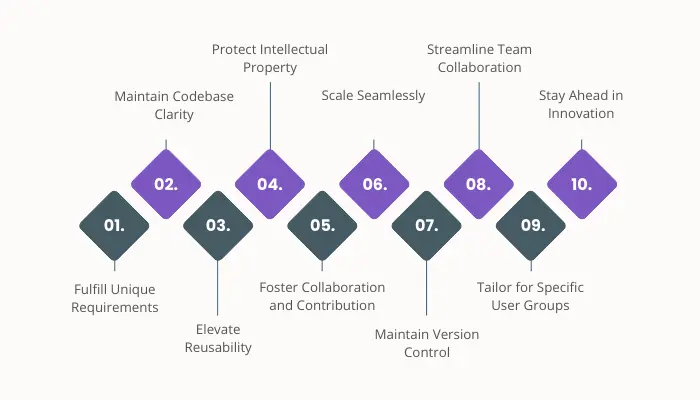
On your journey through Laravel’s versatile realm, you’ll find that custom packaging is your secret weapon for creating tailored solutions that perfectly fit your project’s needs.
Let’s explore why venturing into the world of custom laravel package development can empower your development endeavors like never before.
Reasons are, as mentioned below:
1. Fulfill Unique Requirements
While your project’s requirements don’t quite align with off-the-shelf solutions, it’s time to go for laravel custom package development.
Tailor-making functionalities that cater to your specific needs, ensuring a seamless fit into your application’s architecture.
2. Maintain Codebase Clarity
Another big benefit of creating a laravel package is codebase clarity.
Incorporating specialized features directly into your application can bloat the codebase. With custom laravel packages, you maintain a leaner, cleaner code structure.
Separation of concerns becomes second nature, enhancing readability and maintainability.
3. Elevate Reusability
Imagine crafting a finely tuned piece of functionality that you can reuse across projects.
Moreover, Custom packages encapsulate these functionalities, making them readily available for current and future ventures, saving time and effort.
4. Protect Intellectual Property
When you build unique features, retaining control over your intellectual property is crucial.
Custom laravel package development allows you to secure proprietary code and protect your innovative solutions.
5. Foster Collaboration and Contribution
By sharing your custom packages with the Laravel community, you become a driving force behind collective innovation.
Other web developers can build upon and enhance your work, creating a collaborative cycle of growth.
6. Scale Seamlessly
As your application grows, the need for scalability becomes inevitable.
Laravel packages designed with scalability in mind can adapt and expand alongside your project, ensuring a smooth growth trajectory.
7. Maintain Version Control
With a custom package, you’re in charge of versioning. Updates and improvements can be applied independently, reducing the risk of affecting the main application’s stability.
8. Streamline Team Collaboration
When working in a team, custom packages serve as a centralized resource.
In addition, the team members can collaborate effectively by utilizing standardized functionalities, enhancing consistency and productivity.
9. Tailor for Specific User Groups
Your application might cater to different user groups with varying needs. Custom packages allow you to tailor features for specific user segments, providing a personalized experience.
10. Stay Ahead in Innovation
Custom packages empower you to experiment with cutting-edge technologies, frameworks, and methodologies.
Stay ahead of the curve by integrating groundbreaking solutions into your projects.
Now that you have a reason for creating a laravel package, it’s time to look at how to do so.
Laravel Package Development Process
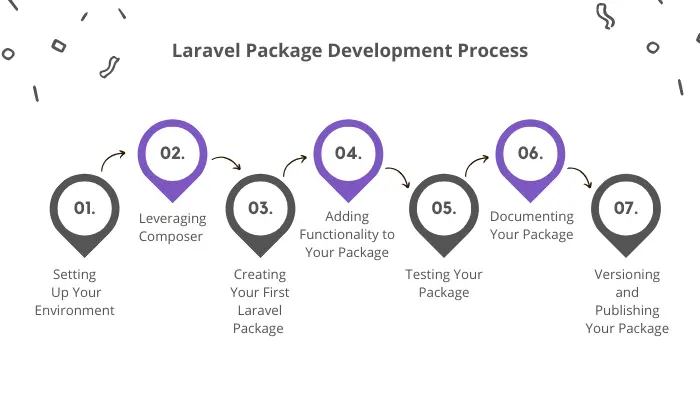
Do you want to create a laravel package?
Custom laravel packaging development is simple. So, hire laravel developers and get right into it.
Here’s how it works:
Step 1: Setting Up Your Environment
The very first step of laravel package development is, setting up the environment.
Ensure your laravel development environment is ready with a functioning Laravel installation. Refer to the official Laravel documentation for guidance.
Step 2: Leveraging Composer
Composer is crucial for managing package dependencies.
Start your package development by using Composer to generate a new Laravel package skeleton:
composer package:generate-vendor/package-name
With this out of the way, it’s time to create the very first laravel package.
Step 3: Creating Your First Laravel Package
-
Folder and Namespace Structure
Create a well-organized structure for your package.
The src folder will hold your package’s core code, while other directories will house configurations, resources, tests, and more.
-
Role of Service Providers
Service providers are the foundation of your package. Extend Illuminate\Support\ServiceProvider to create a provider.
The boot method is where you register resources, routes, and configurations.
-
Configuration and Views
Allow customization by providing configuration files.
Use the php artisan vendor:publish command to publish configuration and view files. This empowers users to modify package behavior.
-
Migrations and Seeders
If your package interacts with a database, include migrations and seeders for a seamless setup process.
Step 4: Adding Functionality to Your Package
-
Building Custom Commands
Simplify tasks for users by introducing custom Artisan commands.
Create new commands using php artisan make:command.
-
Implementing Routes and Controllers
Define routes and controllers within your package. A service provider can be utilized to load these routes.
-
Crafting Blade Components
Enhance reusability by developing Blade components. House your components in the View/Components directory and utilize them in your package’s views.
-
Incorporating Middleware
Enrich your package’s functionality with middleware.
Middleware can be used for tasks like authentication, validation, and more.
Moving on, in the next section of laravel package development, we shall start testing.
Step 5: Testing Your Package
-
PHPUnit Testing Basics
Ensure the reliability of your package by writing PHPUnit tests.
Laravel provides an integrated testing environment. Create new tests using the php artisan make:test command.
-
Setting Up Test Suites
Organize your tests into different suites based on functionalities.
Use PHP Unit’s annotations to set up testing scenarios, including data seeding.
-
Writing Effective Tests
Write comprehensive test cases that cover various scenarios.
Test edge cases, expected behavior, and potential errors. Continuous integration tools like Travis CI can automate your testing workflow.
Step 6: Documenting Your Package
-
Importance of Documentation
Clear documentation is key to your package’s adoption.
Document how to install, configure, and use your package effectively. Include real-world examples and use cases.
-
Generating Clear Documentation
Leverage Markdown to create well-structured and easily navigable documentation.
You can use tools like Laravel Mix for compiling assets and Sami to generate API documentation.
Step 7: Versioning and Publishing Your Package
-
Semantic Versioning Explained
Adopt semantic versioning (SemVer) to communicate changes to users.
Increment the:
- MAJOR version for incompatible changes.
- MINOR version for backward-compatible additions.
- PATCH version for backward-compatible bug fixes.
-
Published in Packagist
Packagist is the primary repository for Composer packages.
Publish your package on Packagist to make it accessible to the Laravel community.
Maintain an accurate composer.json file.
Advanced Package Development Techniques
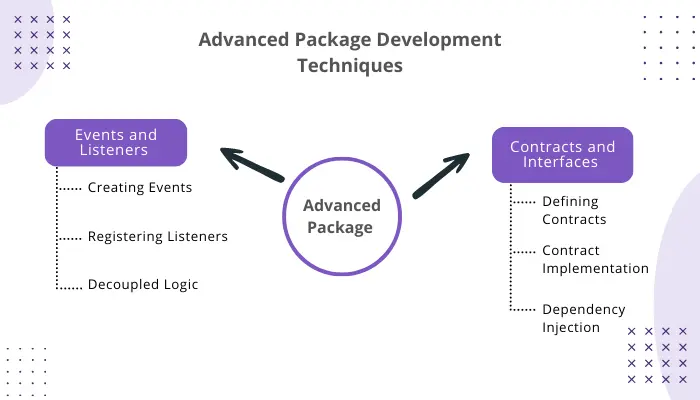
Once you’ve grasped the fundamentals of Laravel package development, it’s time to explore more advanced techniques that can take your packages to the next level.
-
Events and Listeners
Event-driven architecture enables your package to communicate with other parts of the Laravel application without tight coupling.
Learn how to implement events and listeners within your package:
- Creating Events: Define events that represent significant occurrences in your package’s workflow.
- Registering Listeners: Set up listeners to react to specific events and execute custom logic.
- Decoupled Logic: Explore how using events and listeners allows other developers to extend or modify your package’s behavior without altering the core code.
-
Contracts and Interfaces
Contracts and interfaces provide a way to define a set of methods that your package users must implement.
Moreover, this practice enhances code flexibility and ensures adherence to expected behaviors:
- Defining Contracts: Learn how to define interfaces (contracts) for components like services, repositories, or APIs.
- Contract Implementation: Guide users on implementing contracts within their Laravel projects to achieve seamless integration with your package.
- Dependency Injection: Understand how contracts enable dependency injection, making the package’s code more modular and testable.
Packaging Strategies for Different Use Cases
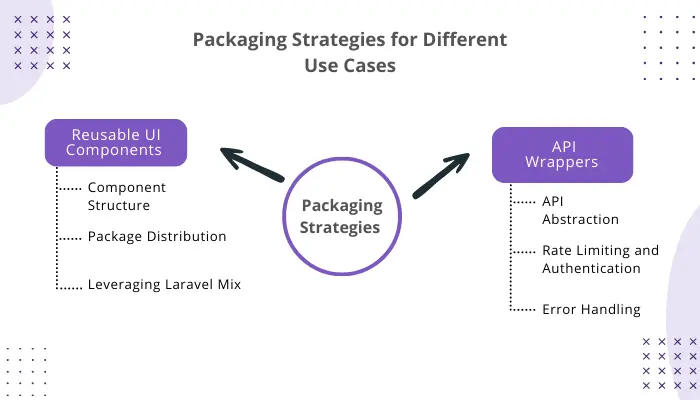
Laravel package development can cater to various use cases, each requiring unique strategies.
Let’s explore some scenarios and how to tackle them effectively.
1. Reusable UI Components
UI components provide a fantastic opportunity to build reusable and customizable pieces of user interface that can be easily integrated into different Laravel projects:
- Component Structure: Break down the anatomy of a UI component, including templates, styles, and JavaScript interactions.
- Package Distribution: Explore how to package UI components in a way that allows users to install and use them effortlessly.
- Leveraging Laravel Mix: Integrate Laravel Mix to compile and bundle assets, simplifying the integration of your UI components.
2. API Wrappers
Creating packages that serve as wrappers around third-party APIs can simplify integration, enhance maintainability, and ensure consistent usage:
- API Abstraction: Understand how to abstract complex API interactions into user-friendly methods and functionalities.
- Rate Limiting and Authentication: Discuss strategies for handling rate limiting, authentication, and token management within API wrapper packages.
- Error Handling: Guide users on how to handle API-specific errors and exceptions effectively.
Best Practices for Package Development
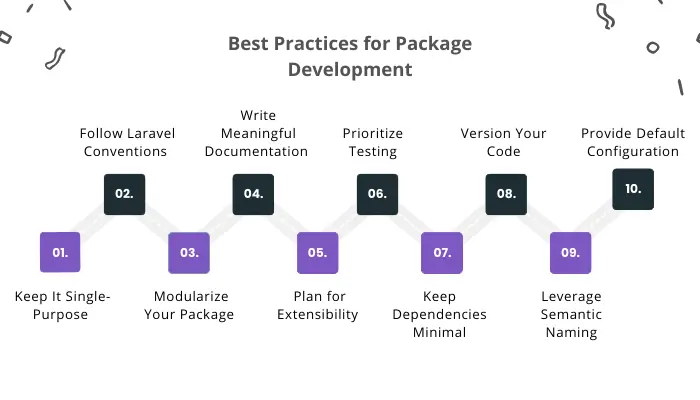
With all the technical stuff out of the way, we shall be discussing some of the best practices laravel package development that you should follow.
So with this being said, let’s get right into it:
-
Keep It Single-Purpose
Design your package to solve a specific problem. Avoid adding unrelated features as this maintains clarity and encourages reusability.
-
Follow Laravel Conventions
Stick to Laravel’s coding standards, naming conventions, and folder structures. This will help your package blend seamlessly with Laravel projects.
-
Modularize Your Package
Organize your package into modular components. This enhances maintainability and makes it easier to extend or customize.
-
Write Meaningful Documentation
Create clear, comprehensive documentation. Explain installation steps, configuration options, and how to use your package effectively.
-
Plan for Extensibility
Design your package with extensibility in mind. Allow users to easily customize and extend functionalities without modifying the core package.
-
Prioritize Testing
Write thorough unit and integration tests to ensure the reliability of your package. This helps prevent regressions as your package evolves.
-
Remaining Dependencies Minimal
Only include dependencies that are essential for your package’s functionality. Minimize unnecessary dependencies to reduce potential conflicts.
-
Version of your Code
Use version control systems like Git to manage your package’s source code. Tag releases using semantic versioning (SemVer) for clear versioning.
-
Leverage Semantic Naming
Choose meaningful and consistent names for classes, methods, and variables. This promotes code readability and clarity.
-
Provide Default Configuration
Offer sensible default configuration values to reduce the initial setup overhead for users.
Common Mistakes to Avoid
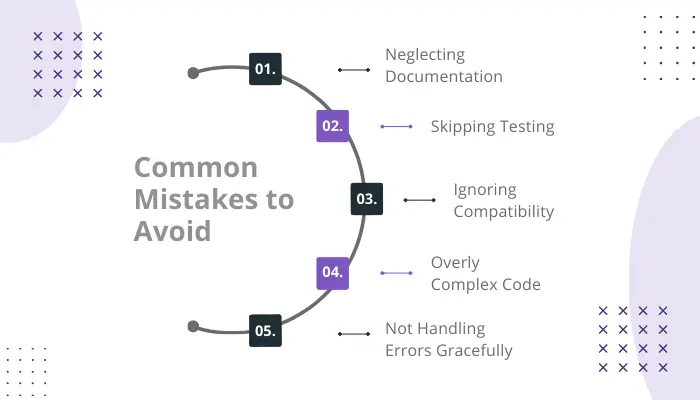
Lastly, it’s time to learn of some common mistakes to avoid when creating a Laravel package. These are, as mentioned below:
1. Neglecting Documentation
Insufficient documentation can frustrate users. Prioritize creating clear, up-to-date documentation that guides users through setup and usage.
2. Skipping Testing
Inadequate testing can lead to bugs and instability. Rigorous testing, including both unit and integration tests, is essential for a reliable package.
3. Ignoring Compatibility
Overlooked compatibility issues can cause problems when new Laravel versions are released. Regularly update your package to ensure compatibility.
4. Overly Complex Code
Complicated code can hinder maintainability. Aim for simplicity and readability to make your package accessible to other developers.
5. No Handling Errors Gracefully
Failing to handle errors and exceptions properly can result in unexpected behavior. Implement meaningful error messages and handling mechanisms.
Conclusion
Congratulations on navigating this comprehensive guide to Laravel package development! Remember, Laravel package development is a continuous learning process. Keep exploring official documentation, experiment with new ideas, and engage with the Laravel community. As you evolve as a developer, consider sharing your experiences and contributing to open-source packages.
FAQ
Service providers boot your package, enabling you to register resources, routes, and configurations. They are crucial for integrating your package seamlessly.
Prioritize data validation, sanitization, and authorization. Implement role-based access control and protect routes and resources using middleware.
Semantic versioning (SemVer) communicates changes clearly. Increment MAJOR for incompatible changes, MINOR for additions, and PATCH for bug fixes.
Use deprecation notices and changelog updates. Provide migration guides for users to transition smoothly to newer versions.
Focus on single-purpose packages, adhere to Laravel conventions, write clean code, and prioritize testing and documentation.
Neglecting documentation, insufficient testing, ignoring compatibility issues, writing overly complex code, and not handling errors gracefully.
Design reusable UI components with templates, styles, and JavaScript interactions. Use Laravel Mix for asset compilation and easy integration.
Explore “Laravel Debugbar” for debugging and profiling, and Spatie’s packages like “Laravel Medialibrary” for media management and “Laravel Permissions” for authorization.
Keep learning, engage with the Laravel community, and contribute to open-source projects. Continually refine your skills and share your knowledge.
Stay engaged with Laravel’s official documentation, attend conferences, follow Laravel-related blogs, and participate in community forums and discussions.

Niketan Sharma is the CTO of Nimble AppGenie, a prominent website and mobile app development company in the USA that is delivering excellence with a commitment to boosting business growth & maximizing customer satisfaction. He is a highly motivated individual who helps SMEs and startups grow in this dynamic market with the latest technology and innovation.
Table of Contents




No Comments
Comments are closed.